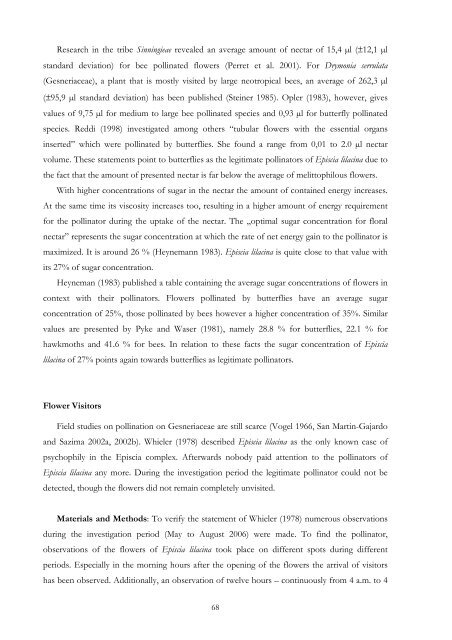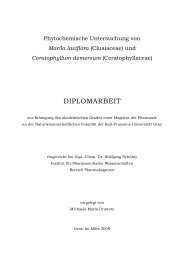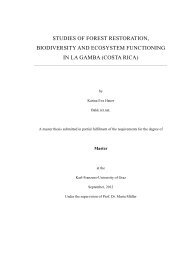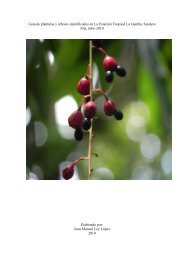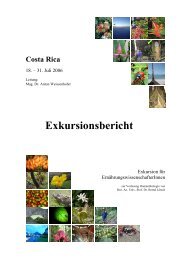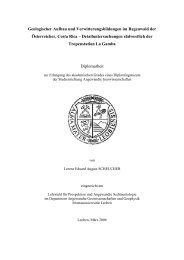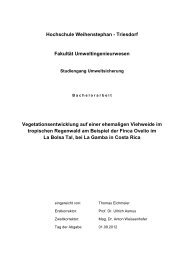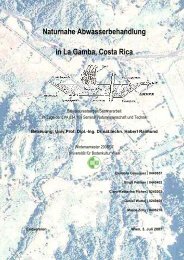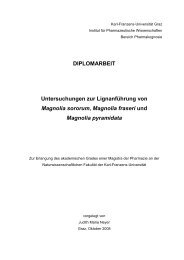Leaf colour patterns, vegetative and sexual reproduction of Episcia ...
Leaf colour patterns, vegetative and sexual reproduction of Episcia ...
Leaf colour patterns, vegetative and sexual reproduction of Episcia ...
You also want an ePaper? Increase the reach of your titles
YUMPU automatically turns print PDFs into web optimized ePapers that Google loves.
Research in the tribe Sinningieae revealed an average amount <strong>of</strong> nectar <strong>of</strong> 15,4 µl (±12,1 µl<br />
st<strong>and</strong>ard deviation) for bee pollinated flowers (Perret et al. 2001). For Drymonia serrulata<br />
(Gesneriaceae), a plant that is mostly visited by large neotropical bees, an average <strong>of</strong> 262,3 µl<br />
(±95,9 µl st<strong>and</strong>ard deviation) has been published (Steiner 1985). Opler (1983), however, gives<br />
values <strong>of</strong> 9,75 µl for medium to large bee pollinated species <strong>and</strong> 0,93 µl for butterfly pollinated<br />
species. Reddi (1998) investigated among others “tubular flowers with the essential organs<br />
inserted” which were pollinated by butterflies. She found a range from 0,01 to 2.0 µl nectar<br />
volume. These statements point to butterflies as the legitimate pollinators <strong>of</strong> <strong>Episcia</strong> lilacina due to<br />
the fact that the amount <strong>of</strong> presented nectar is far below the average <strong>of</strong> melittophilous flowers.<br />
With higher concentrations <strong>of</strong> sugar in the nectar the amount <strong>of</strong> contained energy increases.<br />
At the same time its viscosity increases too, resulting in a higher amount <strong>of</strong> energy requirement<br />
for the pollinator during the uptake <strong>of</strong> the nectar. The „optimal sugar concentration for floral<br />
nectar” represents the sugar concentration at which the rate <strong>of</strong> net energy gain to the pollinator is<br />
maximized. It is around 26 % (Heynemann 1983). <strong>Episcia</strong> lilacina is quite close to that value with<br />
its 27% <strong>of</strong> sugar concentration.<br />
Heyneman (1983) published a table containing the average sugar concentrations <strong>of</strong> flowers in<br />
context with their pollinators. Flowers pollinated by butterflies have an average sugar<br />
concentration <strong>of</strong> 25%, those pollinated by bees however a higher concentration <strong>of</strong> 35%. Similar<br />
values are presented by Pyke <strong>and</strong> Waser (1981), namely 28.8 % for butterflies, 22.1 % for<br />
hawkmoths <strong>and</strong> 41.6 % for bees. In relation to these facts the sugar concentration <strong>of</strong> <strong>Episcia</strong><br />
lilacina <strong>of</strong> 27% points again towards butterflies as legitimate pollinators.<br />
Flower Visitors<br />
Field studies on pollination on Gesneriaceae are still scarce (Vogel 1966, San Martin-Gajardo<br />
<strong>and</strong> Sazima 2002a, 2002b). Whieler (1978) described <strong>Episcia</strong> lilacina as the only known case <strong>of</strong><br />
psychophily in the <strong>Episcia</strong> complex. Afterwards nobody paid attention to the pollinators <strong>of</strong><br />
<strong>Episcia</strong> lilacina any more. During the investigation period the legitimate pollinator could not be<br />
detected, though the flowers did not remain completely unvisited.<br />
Materials <strong>and</strong> Methods: To verify the statement <strong>of</strong> Whieler (1978) numerous observations<br />
during the investigation period (May to August 2006) were made. To find the pollinator,<br />
observations <strong>of</strong> the flowers <strong>of</strong> <strong>Episcia</strong> lilacina took place on different spots during different<br />
periods. Especially in the morning hours after the opening <strong>of</strong> the flowers the arrival <strong>of</strong> visitors<br />
has been observed. Additionally, an observation <strong>of</strong> twelve hours – continuously from 4 a.m. to 4<br />
68


